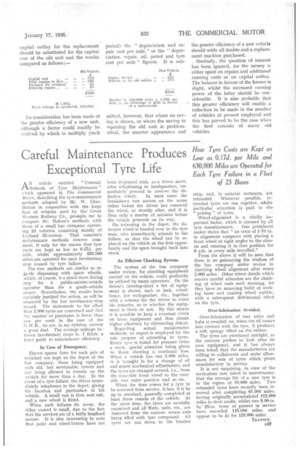When is a Replacement Economically Essential?
Page 50

Page 51

If you've noticed an error in this article please click here to report it so we can fix it.
The Relation of Repair and Depreciation Cost to Economic Vehicle Life. How to Arrive at a Reliable Estimation of Replacement Time. Repair Bills That Total Twice the Original Cost of the Machine
A s a vehicle becomes old and worn, repair bills will become frequent and costly, the time spent under repair will increase and efficiency decrease, petrol and oil consumption will 'become heavier; and appearance will suffer. Nevertheless, many operators consider that " replacement time " depends on mechanical condition, although a consideration of the above facts shows , that the life of a:vehicle can be extended by repairs .and overhauls far beyond the limits of economy.
For convenience of accounting methods, depreciation is often written off over a definite period, . irrespective of mileage .covered. Consequently, claims have been made that the lowest operating costs have been experienced only when the vehicles have been written off the books. This method has been construed still further into a form of licence whereby additional repairs (almost up to the• amount of the previous depreciation) have been incurred and a total operating cost returned which is naturally lower than prior to the " writing-off" period.
Excessive Repair Costs.
In this manner, high repair bills are incurred and, if totalled over the whole life of the vehicle, will often amount to over twice its original cost. It is, therefore, necessary to arrive at a conclusion which will show quite clearly when this repair expenditure should cease.
Dealing first with only the repair aspect and ignoring tonnage carried, because, unless the vehicle be unduly overloaded, the condition of the unit depends chiefly on the distance run, it is submitted that the obvious time to replace any unit is at that point when the two factors, depreciation and repair cost per mile, give the lowest return. To this end, the depreciation is spread over the whole life of the vehicle and applied to its mileage, the same principle being adopted with regard to cumulative repair bills.
These two unit costs are then added together, being termed " depredation and repair cost per mile," and so long as this factor continues to fall, it indicates that the effect of depreciation is greater than the effect of the repairs, and the vehicle Bn is "economic." Conversely, when this cost increases, it shows, without 'doubt, that the additional repair expenditure is having a greater effect than the depreciation, proving that such repairs are "uneconomic." An exarapie is shown graphically, which will help to clarify this case.
In this graph it will be seen that a distinct increase appears, in the second half of 1933, in the " depreciation and repair cost per mile" curve, and this was due to an overhaul, which cost 253. Prior to this expenditure, this curve was still falling and had reached the low cost of 1.57d. per mile for a life mileage of 92,000, the total accumulative repair bill being £295 over its whole life. The calculation required to ascertain whether or not the expenditure of £78 on further repairs was justified was quite simple, as follows :— To return a cost equal to its lowest recorded "depreciation and repair Cost per mile," i.e., 1.574., the total mileage required is shown by simple division, viz., 105,000 miles, or 1.57d.
an additional mileage of 13,000. The decision has then to be made, whether it is reasonable to expect a further 13,000 miles at a running repair C ost comparative with that of a new vehicle. If it be not reasonable to expect this mileage, t h e vehicle should be replaced, but in the case quoted above, no estimate was made, with the result that this uneconomic repair was incurred without the necessary service being obtained. The loss was 105,000 miles multiplied by the difference between 1.57d. and the final figure of the "depreciation and repair cost per mile" curve, 1.70d., which is equivalent to 105,000 multiplied by 0.13d., that is, £57.
CUMULATIVE RE-PAIR.5 PER. MILE
Ascertaining "Replacement Time."
This is the simple method, but an even truer "replacement time" can be deduced, and that is by including cumulative oil, petrol or fuel and tyre costs in the " depredation and repair cost" figure, dividing by the cumulative miles and obtaining a similar, but more comprehensive, factor. • In the method outlined above there is only one assumption made, i.e., that the new vehicle will run as many miles during its life at the same life repair cost as the old unit under consideration. To allow for part exchange, sale value, etc., when making the calculation which decides replacement or repair', the actual capital outlay for the replacement should be substituted for the capital cost of the old unit and the results compared as follows No consideration has been made of the greater efficiency of a new unit, although a factor could readily be evolved by which to multiply (each period) the " depreciation and repair cost per mile," or the "depreciation, repair, oil, petrol and tyre cost per mile " figures. It is sub mitted, however, that where no saving is shown, or where the saving in repairing the old unit is problematical, the smarter appearance and the greater efficiency of a: new vehicle should settle all doubts and a replacement machine purchased.
Similarly, the question of interest has been ignored, for the money is either spent on repairs and additional running costs or on capital outlay. The balance in favour of the former is slight, whilst the increased earning power of the latter should be considerable. It is also probable that this greater efficiency will enable a reduction to be made in the number of vehicles at present employed and this has proved to be the case when the fleet consists of many old vehicles.




























































































